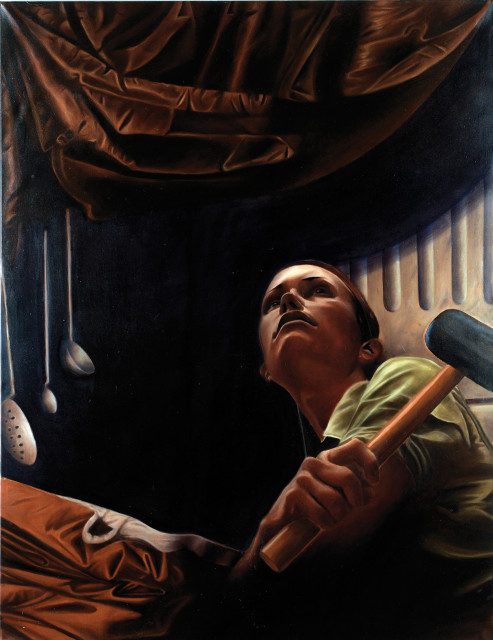Bernhard Buhmann is the rare case of an artist where you can feel the whole impact of art history concentrated in one single painting at a single glance, still a very individual style, a very unique sense for atmosphere and composition is omnipresent. Every painting tells its own story, transforming the canvas into the setting of an epic narration – yet, Bushman’s paintings can be seen as an interrelated body of work, an in-depth investigation of the semantic and grammar of painting, resulting in a self-reflexive process, where the future is as distant as the past: a mysterious parallel universe, another time zone, a world full of irrational, but surprisingly familiar settings.
This is what makes his art timeless: a broad variety of subjects that circle around a very concise theme: Like in a varieté, behind masks and draperies, sliding doors and curtains new perspectives are revealed, vast horizons unfold. Dioramas inhabited by vagabonds, gentlemen and craftsmen, buskers and jesters, premature girls about to set sail, melancholic snowmen melting away. Everything covered with a patina of gold, the dust of mystery, where thunderclouds collide with rainbows: a perfect setting for enigmas and riddles, the mystification of nature, the revitalization of subliminal archetypes.
The composition has a strong focus on balance, but going beyond pure formalist solutions a distinct interest in social context and human behavior is surfacing: the spatial element is the key to reveal the subtext of the script. It works as stage for ideas and ideals, carefully arranged to establish a refined communication between the individual elements. The furniture doesn’t work as a mere prop, its an indispensable element of the plot. The subjects function like actors, always on the edge of representation. The landscape is not a simple backdrop, but fundamentally defines the relation of its characteristic elements. Combined, they form a portentous unity of silence and immobility, a somehow meditative process, a freeze frame of a time out of joint, which creates an enigmatic visual, yet poetic atmosphere.
With an unfathomable vision the paintings walk the thin line between tradition and modernity creating space for challenging the conservative duality of rational and irrational, a kind of new alchemy, merging the surreal with everyday elements. By combining allegories and iconographies all over, a juxtaposition of the common and the strange unfolds, a challenge to eye and mind alike, with the ostinato of a deep-rooted, passionate romanticism. A magnum opus that sucks the audience directly into a narration full of marvel and wonder.
Nevertheless, there is a hint of irony, a bit of sarcasm, playing with the theme of the cult of genius, focusing on the often-neglected complexity of the dichotomy of content and style. In this constant struggle, a unique atmosphere is in the air: You feel the time-consuming act of painting with such an attention to detail, yet there is a fresh spontaneity in the execution, an open-minded innocence meets the skill of a true master. Buhmann is risking a lot by stepping into a tradition, but armed with signature style and will, he turns his back to the conservative corner and is destined for a leap into the spotlight of the very contemporary.
Same time, different place: Bernhard Buhmann | Solo Exhibition
Past exhibition

